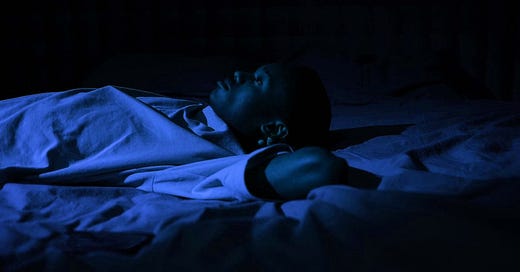I dream of having a broken leg.
What living with chronic pain has taught me about belief, doubt, and the validation we all crave
Truth be told, I'm tired of writing about my chronic pain, but it’s not tired of inhabiting my body. And as much as I'd rather be writing about life on the other side, I still need to process the way that an unexpected disability has been shaping my life since 2020.
"It would be easier if my leg was broken—that way, I wouldn't have to keep explaining my pain."
I can't tell you when this thought first materialized, but I can confirm that I meant every word.
I spent about four years waking up to a life defined by my invisible disability—a herniated disc that sent pain radiating up my back and into my neck. Every morning when my alarm clock went off, the first question that popped into my head was "what type of pain will I experience, today?"
Every day involved some form of pain—some days, it was manageable. Other days, it made my world stop. But every day, there was pain.
When chronic pain became an inescapable part of my lived experience, it didn't just steal my physical stamina—it robbed me of my capacity to dream about my next vacation, or my daughter's future, or my next date with my wife.
I don't spend as much time dreaming about once-in-a-lifetime experiences or remarkable breakthroughs anymore—Instead, most of my dreams are more fundamental.
I dream about a life that is not defined by chronic pain.
I dream about a life where I can carry my daughter without worrying about whether or not I'll be able to sit up straight the next day.
I dream about planning next month without fear. I dream about planning next year without asterisks.
And on the days when I can't stretch my imagination far enough to envision a pain-free life, I dream about having a predictable injury with a beginning, middle, and end.
I dream about not rehearsing explanations before every social event, not seeing the flash of doubt in someone's eyes when I decline their invitation again.
I dream about having a broken leg. This might sound strange to anyone who hasn't experienced chronic invisible pain, so let me explain.
To be fair, I've never had a broken bone in my body, and I don't want to diminish the genuine difficulty of such injuries. I'm not competing in the Oppression Olympics.
But a cast tells a story I'm tired of repeating. Having a visual marker of your injury makes a profound difference in daily interactions.
When your disability is invisible, you don't just manage your pain—you manage the energy required to explain it, over and over, to people who may or may not believe you.
I've memorized an exhaustive defense of my condition, and the work I've been doing to heal:
"I've been to four physical therapists, three primary care physicians, an acupuncturist, five massage therapists, a podiatrist, and a 'spine specialist' who turned out to be a scammer. I stretch every day. Yes, I mind my posture. Yes, my chair has lumbar support."
The difference is stark: A broken leg comes with a timeline—six weeks to six months of healing, depending on severity. Chronic pain offers no such certainty. Six more weeks? Six more years? No doctor can say.
More importantly, a cast earns automatic grace. People understand your grimaces, your canceled plans, your requests for help. With an invisible disability, every limitation becomes something to justify, every accommodation something to negotiate. You're not just navigating your injury; you're navigating others' skepticism about its very existence.
This additional emotional labor takes a toll that's rarely acknowledged.
I don't expect everyone to understand my invisible pain—how could you? But I do wish for a world where we'd approach each other with more grace. If I cancel plans last minute, believe me that I wanted to be there.
If I grimace when standing up, don't automatically offer medical advice. What I need most is compassionate presence, not problem-solving.
If I mention my disability, a simple "That sounds difficult. How can I support you today?" goes further than curious interrogation or well-intentioned suggestions.
The most meaningful support often comes from those who don't require proof of my pain—who accept my limitations without needing the medical history or a catalog of failed treatments. Those who understand that some days I can deadlift almost double my body weight, and other days I can barely walk to the mailbox—and neither day makes the other less real.
At its core, this essay isn't actually about pain or disability.
Perhaps the broken leg I dream of isn't about the cast at all—it's about the unquestioned acceptance of my reality that comes with it.
I envision a world where we believe people's experiences without requiring a binder of supporting evidence, where we trust that each person is the expert of their own body, and where we offer support without demanding justification.
What’s new:






I have CP and feel exactly the same way. Funnily enough it was also true for me when I was diagnosed with depression in 2000. MH wasn't as well understood or accepted and I didn't know how to explain social or professional 'inconsistencies'. We can only hope that the acceptance of CP advances the same way as MH has but quicker. Kindness is key.
It’s a shame how many ways we’re expected to “prove” our pain. I am so sorry you’re going through this. There’s a community of people suffering in silence that you’re giving a voice to here. 🙏🏾🖤